For many elderly individuals, enjoying a simple cup of coffee or tea becomes a source of anxiety rather than pleasure.
Tremors from Parkinson’s disease, weakness from stroke, arthritis-related grip difficulties, or cognitive decline from dementia can transform the routine act of drinking into a potential safety hazard involving spills, burns, and embarrassment.
Spill-proof coffee cups designed specifically for elderly users address these challenges by combining innovative leak-prevention technology with lightweight, easy-to-handle designs that restore confidence and independence.
Unlike standard travel mugs that prioritize portability over accessibility, elderly-focused spill-proof coffee cups incorporate thoughtful design elements that balance complete spill prevention with ease of use for individuals with limited strength, dexterity, or cognitive function.
These specialized cups prevent dangerous hot liquid spills that could cause burns, reduce cleaning burden for caregivers, eliminate the embarrassment of accidents, and, most importantly, encourage adequate hydration by removing the fear and anxiety associated with drinking.
In this comprehensive guide, we’ll explore everything you need to know about spill-proof coffee cups for elderly users: how they work, key features to prioritize, specific designs for different needs, and how to select the perfect cup for various conditions and situations.
Understanding Spill-Proof Technology for Elderly Users
Spill-proof coffee cups utilize various mechanisms to prevent liquid from escaping when the cup tips, shakes, or gets knocked over.
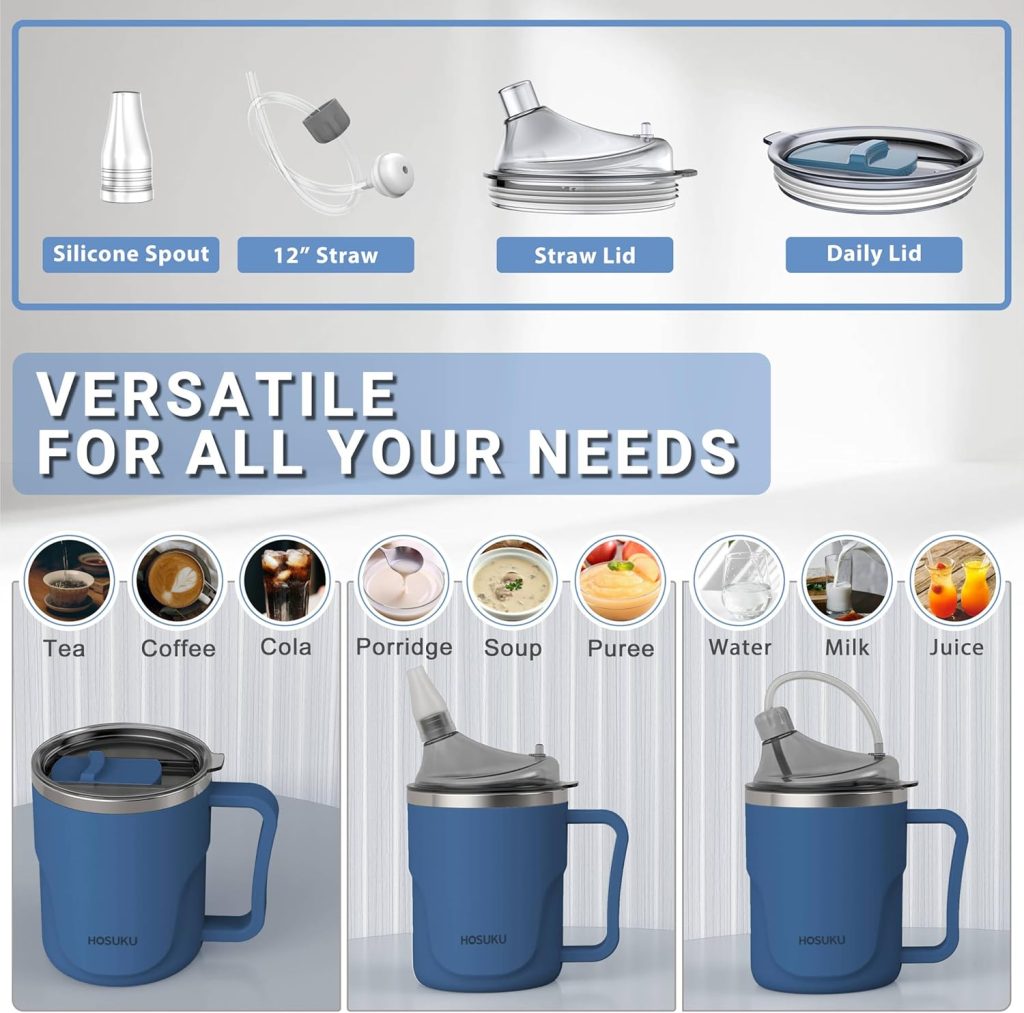
The most effective designs for elderly users balance complete leak prevention with accessibility—ensuring the spill-proof features don’t create new barriers that prevent independent use.
Sealed Lid Systems
The most common and effective spill-proof design features a tightly sealed lid with a controlled drinking spout or valve-activated opening.
These lids create an airtight seal that prevents spills even when the cup is tipped significantly or turned upside down.
The drinking mechanism typically includes a valve that opens only when the user actively sips, automatically closing between drinks to maintain the seal.
360-Degree Valve-Activated Rims
Some innovative spill-proof cups feature valve-activated edges that allow drinking from any point around the rim, similar to a regular cup, but automatically seal when pressure is released.
This design feels more natural and dignified for elderly users who may be resistant to cups that look too “special” or childlike.
Weighted Anti-Tip Bases with Splash Guards
Another approach combines a heavily weighted base that makes the cup extremely difficult to knock over with a splash-guard lid that minimizes spills from sloshing during tremors or unsteady handling.
While not completely spill-proof if forcefully tipped, these cups provide significant protection during normal use.
Combination Handle and Lid Systems
The most sophisticated designs integrate ergonomic handles with secure, easy-to-operate spill-proof lids, creating a comprehensive solution that addresses both grip security and liquid containment.
Why Spill-Proof Coffee Cups Matter for Elderly Safety and Independence
The benefits of spill-proof coffee cups extend far beyond simple convenience:
Prevents Serious Burn Injuries
Hot coffee or tea spills pose significant burn risks, particularly for elderly individuals whose skin has become thinner and more fragile with age.
Even moderate-temperature liquids that might cause minor discomfort to younger people can create serious burns on elderly skin.
Spill-proof lids contain hot liquids even during severe tremors, accidental bumps, or drops, dramatically reducing burn risk.
This protection is especially crucial for individuals with Parkinson’s disease, essential tremor, or post-stroke weakness, where hand stability is severely compromised.
Eliminates Anxiety and Embarrassment
Many elderly individuals develop profound anxiety around drinking beverages, fearing the mess, embarrassment, and burden they might create if spills occur.
This anxiety can actually suppress fluid intake, leading to dehydration and related health problems.
Spill-proof cups remove this psychological barrier, allowing seniors to drink confidently anywhere in their home without constant worry.
Encourages Adequate Hydration
Dehydration is a serious problem among elderly populations, contributing to urinary tract infections, kidney problems, confusion, falls, and hospitalizations.
When elderly individuals avoid drinking because they fear spills, their health suffers.
Spill-proof cups eliminate this barrier, promoting the consistent fluid intake essential for cognitive function, kidney health, medication effectiveness, and overall well-being.
Supports Independence During Cognitive Decline
For individuals with dementia or Alzheimer’s disease, spill-proof cups provide a critical safety net during moments of confusion, disorientation, or agitation.
Even if the cup is set down carelessly, forgotten on its side, or knocked during an episode of restlessness, the spill-proof mechanism protects both the user and the environment from dangerous hot liquid exposure.
Reduces Caregiver Burden
Frequent spills create significant extra work—cleaning floors and furniture, changing clothing and bedding, and laundering soiled items.
Spill-proof cups dramatically reduce this burden, freeing caregivers to focus on more meaningful interactions and care activities rather than constant cleanup.
Enables Bedside and Recliner Independence
Spill-proof cups can safely remain on bedside tables, wheelchair trays, or beside recliners, allowing elderly individuals to take nighttime medications with water, enjoy morning coffee before rising, or stay hydrated throughout the day without calling for assistance.
This independence is psychologically valuable and practically important for maintaining autonomy.
Spill-Proof Coffee Cups for the Elderly with Lids
Lid design is the most critical factor determining both spill prevention effectiveness and ease of use for elderly individuals.
The ideal lid must be completely leak-proof while remaining simple enough for arthritic hands, weakened grip, or confused minds to operate independently.
Types of Spill-Proof Lids for Elderly Users
Flip-Top Spout Lids: These feature a hinged spout that flips open with light pressure from a thumb or finger, revealing a drinking opening.
When closed, the spout creates a tight seal. The best flip-top designs require minimal finger strength—look for large, textured flip tabs that are easy to grasp and operate even with limited dexterity.
Slide-Open Mechanisms: These lids feature a sliding panel that covers the drinking spout. Users slide the panel to one side to drink, then slide it closed for spill protection.
While intuitive, ensure the sliding mechanism operates smoothly without requiring excessive force that arthritic fingers cannot provide.
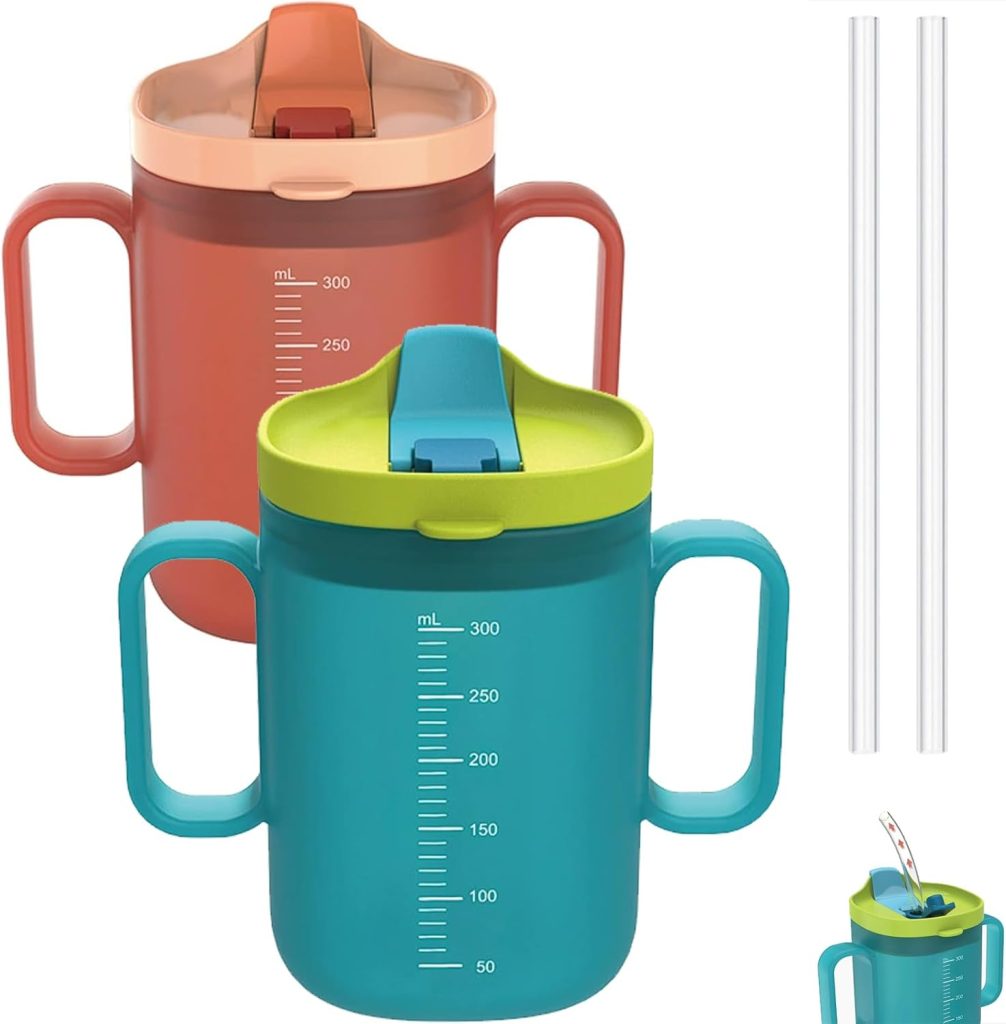
Twist-Off Lids with Valve Inserts: Some cups feature a simple twist-off lid that reveals a valve-controlled drinking spout underneath.
The outer lid provides spill protection during storage or transport, while the valve spout allows drinking without complete lid removal.
This two-stage system works well for users who can manage simple twisting motions.
Straw-Style Lids with Closeable Spouts: These incorporate a built-in straw or straw port with a flip or slide cover.
The straw draws liquid up, reducing the need to tip the cup beneficial for users with neck mobility limitations or tremors that make tilting difficult.
Key Features for Elderly-Friendly Lids
Large, Easy-to-Grip Opening Mechanisms: Avoid tiny buttons, small latches, or mechanisms that require precise finger placement.
The opening mechanism should be large enough for multiple fingers to operate simultaneously and positioned where it’s easily visible and accessible.
Color-Coded or Textured Indicators: Lids should have obvious visual or tactile cues showing where to drink from and whether the lid is properly sealed.
Bright colored indicators (red for closed, green for open) or raised markings help users with vision problems identify the drinking spout and verify correct closure.
One-Handed Operation: The lid should open and close using only one hand, accommodating stroke survivors or individuals with one weak arm.
Test this by attempting to open the lid while holding the cup with the same hand.
Positive Closure Feedback: The lid should click, snap, or provide clear resistance when properly closed, giving users tactile confirmation that the spill-proof seal is engaged.
Ambiguous closures create anxiety about whether the cup is truly safe.
Wide Drinking Opening: While the lid must seal tightly, the drinking opening should be large enough for comfortable sipping without requiring precise lip placement—important for users with tremors or limited fine motor control.
Dishwasher-Safe and Easy to Clean: Lids with complex valve systems can harbor bacteria if not cleaned properly.
Choose designs that disassemble easily for thorough cleaning and are top-rack dishwasher safe to reduce caregiver burden.
Best Spill-Proof Lids for Specific Conditions
For Arthritis: Choose flip-top lids with large, textured tabs that require minimal pinch strength. The Contigo AutoSeal lid design works well, though verify the button isn’t too stiff.
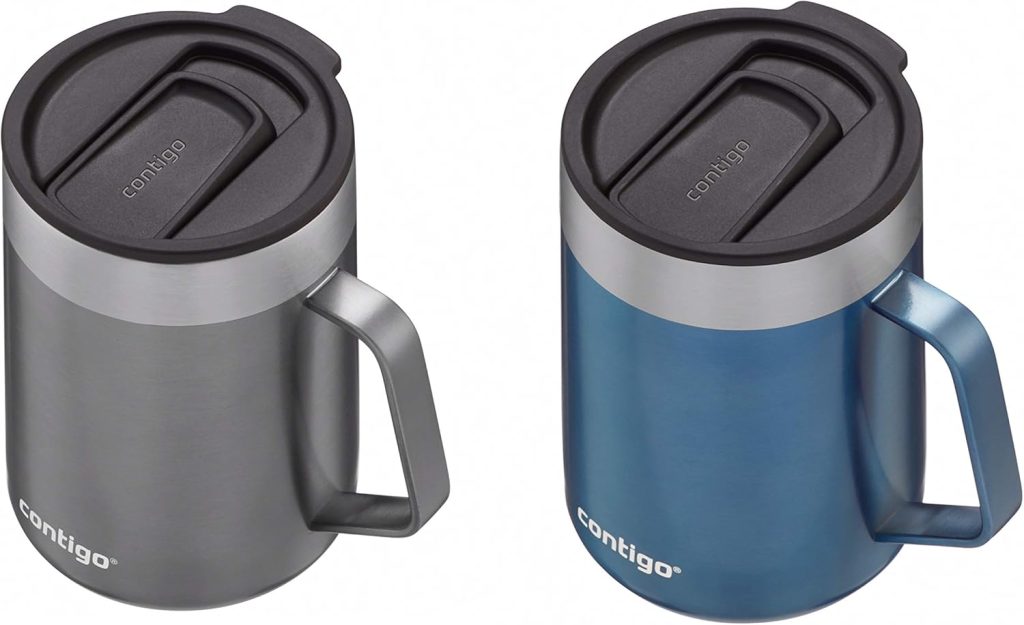
For Parkinson’s or Tremors: Slide-open mechanisms often work better than flip-tops because they don’t require the sustained pinch grip that’s difficult during tremors.
Look for wide slide tracks that tolerate imprecise finger movements.
For Dementia: Simple twist-off lids with permanent valve spouts underneath eliminate the step of remembering to open/close a spout.
Once the outer lid is removed, the cup is ready to drink from, regardless of cognitive state.
For Stroke Recovery (One-Handed Use): Flip-top lids that operate with thumb pressure while fingers grasp the cup body enable complete one-handed operation from opening through drinking to closing.
Spill-Proof Coffee Cups for the Elderly with Handles
Handle design dramatically affects whether elderly individuals can successfully use spill-proof coffee cups independently.
Poor handle design can negate all the benefits of spill-proof technology if users cannot grip the cup securely enough to lift it safely.
Why Handles Matter for Elderly Users
Arthritis, reduced grip strength, hand tremors, and reduced finger dexterity make grasping and lifting cups increasingly difficult as people age.
Handles provide a secure gripping point that distributes lifting force across more of the hand, reducing the precision and strength required compared to grasping the cup body directly.
For elderly users, the right handle can mean the difference between independent drinking and requiring assistance.
Types of Elderly-Friendly Handles
Large Loop Handles: Handles with loops large enough to accommodate four fingers (or an entire hand for users with very weak grip) provide maximum security.
Look for handle openings at least 2.5 to 3 inches wide and 3 to 4 inches tall. These oversized handles allow users to “hang” the cup from their hand rather than gripping it, reducing the strength required.
Dual-Handle Designs: Some spill-proof cups feature two handles on opposite sides, providing options for two-handed lifting (both hands on the cup for maximum stability) or easy transfer between hands.
Dual handles also accommodate users who have a weaker preferred side—they can choose which handle to use based on which hand is functioning better at any given moment.
Ergonomic Contoured Handles: Rather than simple circular loops, the best handles feature ergonomic contours that fit the natural shape of relaxed fingers.
These contours often include a thumb rest at the top and finger indentations along the grip surface, reducing the effort needed to maintain grip.
Textured or Rubberized Grips: Handles with textured, grooved, or rubberized surfaces provide additional friction that prevents slipping even when hands are weakened or unsteady.
This feature is particularly important for users with Parkinson’s or essential tremor, where maintaining consistent grip pressure is difficult.
Key Handle Features for Elderly Users
Adequate Size: The handle must be large enough that arthritic, swollen, or stiff fingers fit comfortably through the opening without forcing or squeezing.
Comfortable Weight Distribution: The handle should be positioned to balance the cup’s weight naturally, preventing wrist strain.
When the cup is lifted by the handle, it should hang in a comfortable drinking angle without requiring excessive wrist rotation.
Smooth Edges: Handle edges should be rounded and smooth—never sharp or thin—to prevent discomfort or pressure points on fingers during prolonged holding.
Secure Attachment: The handle must be extremely securely attached to the cup body, as elderly users may apply uneven or awkward force.
Molded-in or reinforced handles are superior to glued-on designs that might separate over time.
Insulated Handle Separation: For cups holding hot liquids, the handle should be thermally separated from the cup body so it remains cool to the touch even when the beverage is very hot.
This prevents burns and allows comfortable gripping.
Best Spill-Proof Coffee Cups with Handles for Specific Needs
For Severe Arthritis: The Sammons Preston Dignity Mug features an exceptionally large D-shaped handle with 3-inch clearance that accommodates severely swollen or deformed arthritic hands.
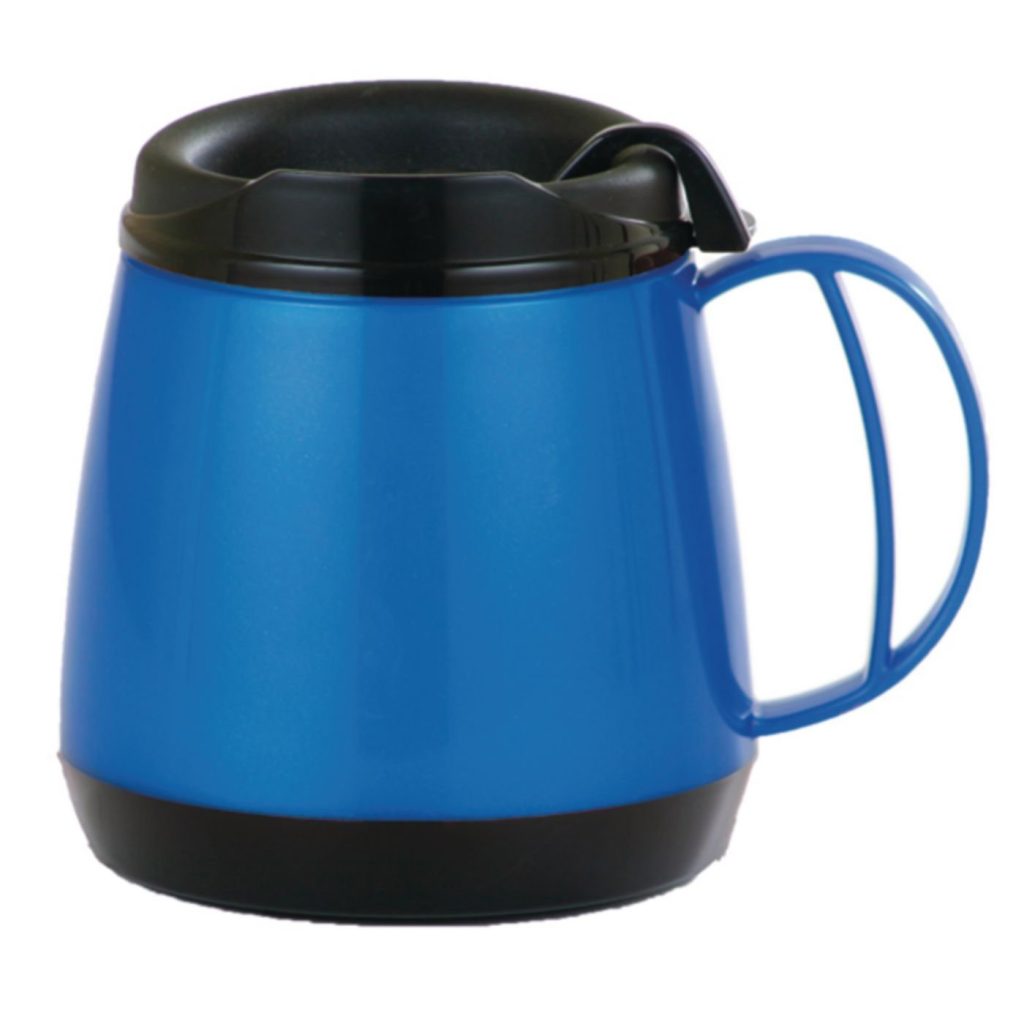
The lightweight construction (under 6 ounces empty) minimizes lifting strain.
For Parkinson’s Disease: The Liftware Steady Mug incorporates stabilization technology along with a wide, rubberized handle.
While heavier than standard cups, the active tremor compensation makes it worth the extra weight for Parkinson’s patients.
For Stroke Recovery: The Aidapt Caring Mug features a large loop handle positioned for easy one-handed lifting, combined with a wide non-slip base and simple snap-on spill-proof lid.
The 12-ounce capacity reduces refill frequency.
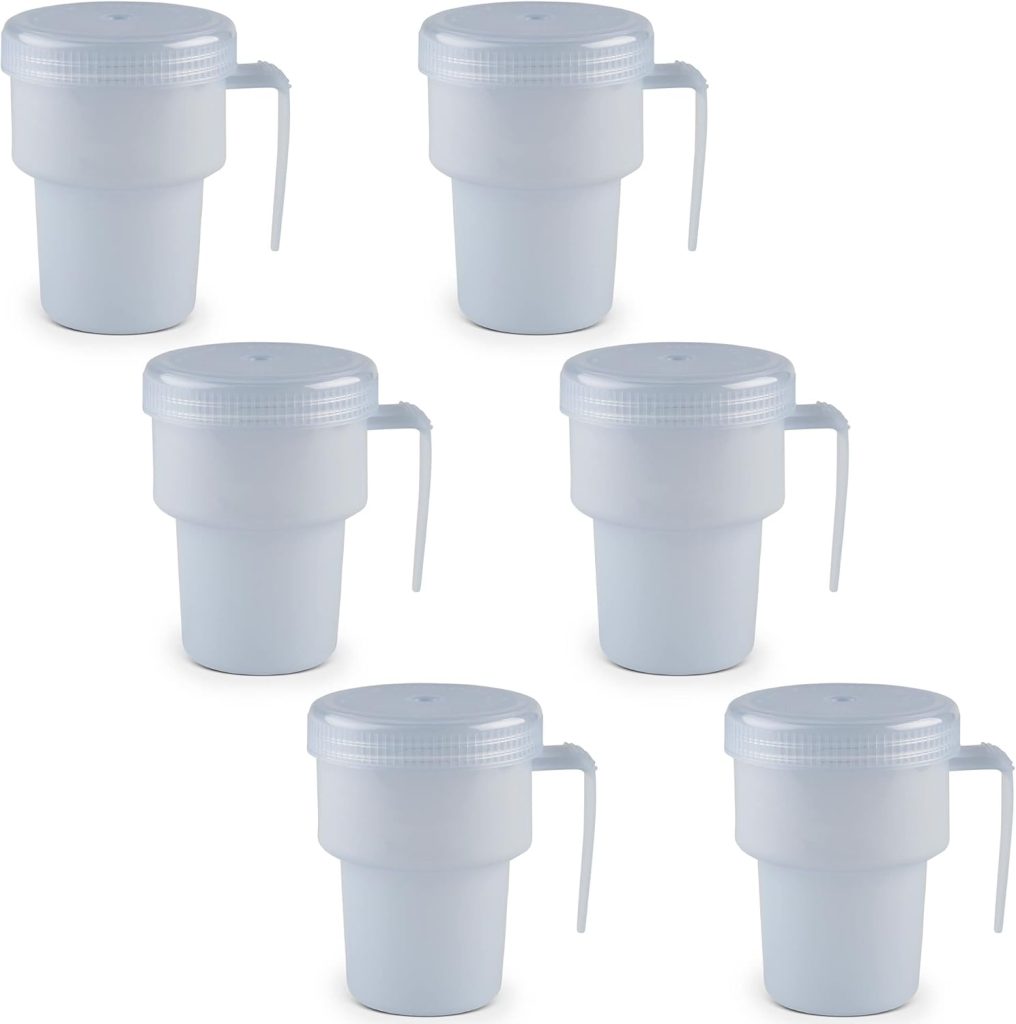
For General Elderly Use: The Kennedy Cup with ergonomic handle offers a balanced design suitable for various conditions, featuring a comfortable contoured grip, 14-ounce capacity, and a completely sealed spill-proof lid.
Two-Handle Designs for Maximum Stability
For elderly users with severe tremors or bilateral weakness, cups with two handles provide exceptional stability:
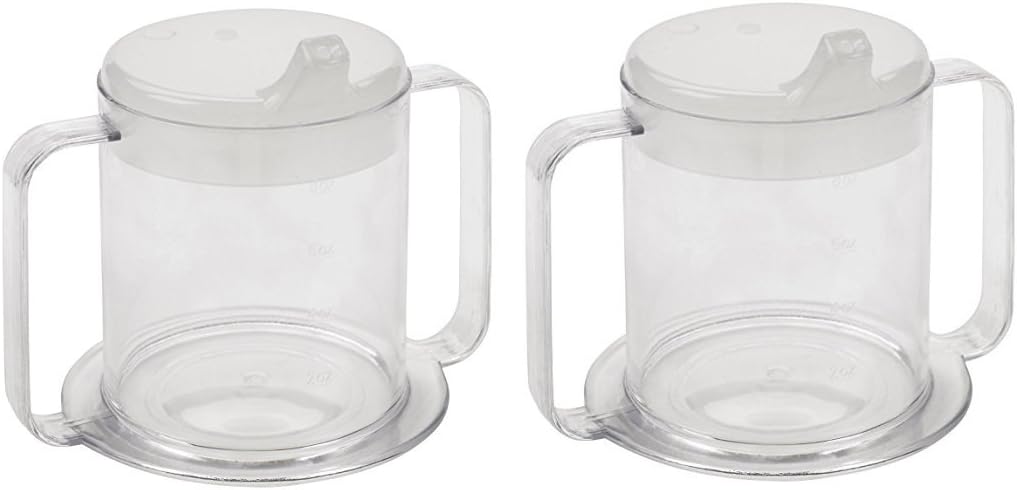
The Medline Double Handle Insulated Cup features two large loop handles on opposite sides, allowing users to grip with both hands for maximum control.
The 16-ounce insulated design keeps beverages at safe temperatures longer, and the spill-proof lid with flip spout is easy to operate even with limited dexterity.
The Patterson Medical Two-Handled Mug offers a more traditional appearance with its ceramic-style design, but includes dual ergonomic handles and a secure snap-on spill-proof lid.
The 12-ounce capacity is appropriate for tea or coffee servings.
Handle Positioning and Orientation
Consider where the handle sits relative to the spill-proof lid’s drinking spout. Ideally, the handle should position the drinking spout naturally toward the user’s mouth when lifted, eliminating the need to rotate the wrist or adjust cup positioning movements that are difficult for many elderly individuals.
Large Spill-Proof Coffee Cups for the Elderly
Capacity is an often-overlooked but critically important factor when selecting spill-proof coffee cups for elderly users.
Large-capacity cups (14-20 ounces) offer distinct advantages over standard 8-12 ounce cups, though they also present some challenges that must be carefully considered.
Why Large Capacity Matters
Reduces Refill Frequency: Each time an elderly person needs a refill, multiple steps are required: traveling to the kitchen, operating the coffee maker or kettle, pouring hot liquid (burn risk), and returning to their seat.
Large capacity cups reduce how often these potentially dangerous trips occur, decreasing fall risk and burn exposure while supporting independence.
Encourages Adequate Hydration: Larger cups make it easier to consume sufficient fluids throughout the day.
Rather than needing to remember to refill multiple times (difficult for those with cognitive decline), a single large cup provides adequate hydration for several hours.
Maintains Temperature Longer: Larger volumes of liquid retain heat longer, meaning the beverage stays at a comfortable drinking temperature throughout an extended period.
This is particularly valuable for slow drinkers who might otherwise need to reheat their beverage multiple times.
Accommodates Thickened Liquids: Many elderly individuals with dysphagia (swallowing difficulties) require thickened liquids.
Thickening agents reduce the effective volume of drinkable liquid, so larger cups are necessary to provide adequate fluid intake.
Better for Medication Schedules: Elderly individuals taking multiple medications throughout the day benefit from having a large volume of liquid readily available for medication administration without needing to refill constantly.
Challenges of Large-Capacity Cups
Increased Weight: A 16-ounce cup filled with liquid weighs over one pound—potentially too heavy for elderly users with significant weakness or advanced arthritis.
This must be carefully balanced against the benefits.
Stability Concerns: Taller cups (necessary for larger capacity) have a higher center of gravity, making them potentially easier to knock over.
This is particularly concerning for users with tremors or impaired coordination.
Temperature Safety: Larger volumes of hot liquid represent more potential burn damage if a spill does occur. The spill-proof features become even more critical with large-capacity cups.
Drinking Difficulty: Very tall cups may require more neck extension or cup tilting to access the liquid, which can be difficult for users with neck arthritis or swallowing problems.
Key Features for Large Spill-Proof Coffee Cups
Wide, Weighted Base: Large cups absolutely must have wide, stable bases—ideally weighted or with non-slip features—to compensate for their higher center of gravity.
Look for base diameters at least 3-4 inches wide for 16-20 ounce cups.
Insulation: Large volumes cool slowly, but without insulation, they can become lukewarm and unpleasant.
Double-walled construction maintains temperature without adding excessive weight compared to single-wall designs that would require thicker, heavier materials for the same insulation.
Ergonomic Handle Placement: With larger, heavier cups, the handle design becomes even more critical.
The handle must be positioned to distribute the increased weight comfortably and may need to be reinforced to handle the greater forces involved.
Gradual Taper Design: Rather than straight cylindrical shapes, the best large cups taper slightly from bottom to top, creating a lower center of gravity while maintaining good capacity.
This design improves stability significantly.
Clear Volume Markings: Large cups should include measurement markings so users and caregivers can monitor fluid intake accurately, particularly important for those with medical conditions requiring fluid monitoring.
Appropriate Lid Size: Larger cups need proportionally larger lids with bigger drinking openings to make accessing the liquid easier despite the greater depth.
Ensure the lid’s spout or opening is designed for the cup’s height.
Best Large Spill-Proof Coffee Cups for the Elderly
The Contigo West Loop (20 oz): This large-capacity travel mug features AUTOSEAL technology that’s completely spill-proof, a comfortable handle, and excellent insulation.
While designed as a travel mug, it works exceptionally well for elderly home use. The one-button operation is simple enough for most users.
Thermos Guardian Collection (18 oz): This large insulated mug includes a built-in handle, a wide stable base, and an easy-flip lid with a spill-proof seal.
The soft-touch grip adds security, and the large capacity reduces refill frequency for elderly users.
Medline Insulated Tumbler (16 oz): Specifically designed for elderly and healthcare settings, this large cup features a snap-on spill-proof lid, two handles for stability, excellent insulation, and a wide base.
The institutional-grade construction withstands daily use.
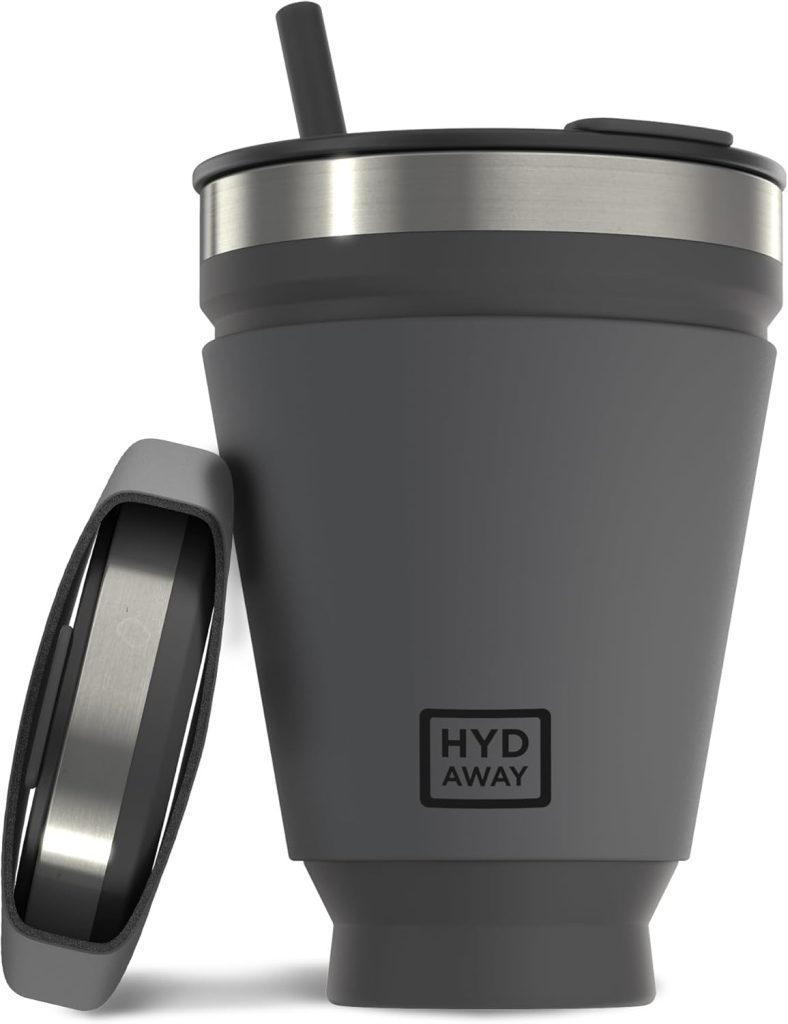
Hydaway CollapsiBowl Travel Mug (16 oz): This innovative design offers large capacity with a weighted base for stability, 360-degree drinking edge (feels like a regular cup), and complete spill-proof protection when the lid is closed. The wide form factor creates a lower center of gravity.
Sammons Preston Independence Mug (20 oz): This extra-large capacity mug features a huge ergonomic handle, stable weighted base, and simple twist-on spill-proof lid.
While heavier than some alternatives, it’s ideal for elderly users with adequate strength who need maximum capacity.
Balancing Capacity with User Ability
Selecting the right capacity requires an honest assessment of the user’s physical capabilities:
For users with good strength, 16-20 ounce cups provide maximum benefit with minimal downside. Choose models with excellent handles and wide bases.
For users with moderate weakness: 12-14 ounce cups offer a good compromise—larger than standard but not so heavy as to be unmanageable.
Focus on lightweight materials like BPA-free plastic rather than stainless steel.
For users with significant weakness: Even with a large capacity available, 10-12 ounce cups may be the practical maximum.
In these cases, consider using two smaller cups (one for morning, one for afternoon) rather than forcing a single large cup that’s too heavy.
Partial Filling Strategy: Another approach is purchasing a large-capacity cup but only filling it halfway or two-thirds full.
This provides the stability of a wide, weighted base while keeping the actual weight manageable.
As liquid is consumed, the cup becomes even lighter while maintaining spill-proof protection.
Testing and Adjustment
When introducing a large spill-proof coffee cup, start with partial fills to ensure the user can safely handle the weight. Gradually increase the fill level as confidence builds.
Monitor for signs of strain, dropping, or difficulty lifting. If a 16-ounce cup proves too heavy when full, it may still work perfectly with 10-12 ounces of liquid.
Combining Features: The Ultimate Elderly-Friendly Spill-Proof Coffee Cup
The ideal spill-proof coffee cup for elderly users combines multiple adaptive features into a single, comprehensive solution:
Essential Features:
- Complete spill-proof sealed lid with easy-to-operate mechanism
- Large ergonomic handle or dual handles for secure grip
- Lightweight construction (6-10 oz empty, depending on capacity)
- Wide, non-slip or weighted base for stability
- 12-16 oz capacity for reduced refill frequency
- Thermal insulation to maintain a safe drinking temperature
- BPA-free, food-grade materials for safety
- Dishwasher safe for easy cleaning
- Clear or bright colored body for visibility
- Wide mouth opening for easy filling and cleaning
Bonus Features:
- Measurement markings for fluid intake monitoring
- Textured or rubberized grip surfaces
- High-contrast color design for visual impairment
- Straw compatibility for users who prefer straw drinking
- Microwave-safe construction for reheating
Products that come closest to this ideal include the Medline Insulated Tumbler, the Aidapt Caring Mug, and specialized adaptive drinking cups from companies like Sammons Preston and Patterson Medical that focus specifically on the elderly and disability markets.
Special Considerations for Different Conditions
For Parkinson’s Disease: Choose cups with weighted bases (helps counter tremors), wide handles with rubberized grips, and flip-top lids rather than twist-off designs.
The extra weight of insulated stainless steel cups can actually help stabilize drinking despite being heavier to lift.
For Stroke Recovery: One-handed operation is paramount. Every feature—lid opening, cup lifting, drinking, lid closing—must be possible with a single hand. Large loop handles and flip-top lids work best.
For Arthritis: Lightweight is critical. Choose the lightest materials available (BPA-free plastic over stainless steel), oversized handles that don’t require tight gripping, and lid mechanisms with large, easy-to-push buttons or tabs rather than twist-off designs.
For Dementia: Simple, intuitive designs prevent confusion. Avoid complex multi-step lid operations. Bright colors help with visibility and recognition.
Consider cups that are always “ready to drink” without needing to remember lid operations.
For Dysphagia (Swallowing Difficulties): Some users need straw-based spill-proof cups that allow controlled sipping.
Others benefit from cups with built-in flow restrictors that limit intake per sip, preventing choking. Consult with a speech therapist for specific recommendations.
Introduction, Strategy, and User Acceptance
Even excellent spill-proof coffee cups may face resistance from elderly users who view them as embarrassing or as symbols of declining independence. Successful introduction requires sensitivity:
Positive Framing: Present the cup as a convenient modern product that “keeps drinks at the perfect temperature” or “prevents mess on furniture” rather than as medical equipment for disabilities.
Gradual Adoption: Start using the spill-proof cup for specific situations—”your TV watching cup” or “your bedtime water cup”—rather than insisting on full-time replacement of favorite regular cups.
Family Normalization: Have other family members use similar spill-proof cups, making it a household choice rather than “special equipment.”
Choice and Control: Offer several options and let the elderly person choose their favorite color, style, or design. This preserves autonomy and increases acceptance.
Emphasize Benefits: Focus on what the cup enables (“you can enjoy coffee in the living room without worry”) rather than what it compensates for.
Cleaning and Maintenance
Proper care ensures spill-proof cups remain hygienic and functional:
Daily Cleaning: Disassemble all lid components completely and wash with warm, soapy water after each use. Pay special attention to valve mechanisms, spouts, and seal areas where bacteria can accumulate.
Use a small bottle brush or straw cleaning brush for spouts and valve ports.
Weekly Deep Clean: Soak lid components in a 1:1 white vinegar and water solution for 15-20 minutes weekly to prevent odor buildup and eliminate any mildew or bacteria. Rinse thoroughly afterward with clean water.
Gasket and Seal Inspection: Check silicone gaskets, valve seals, and o-rings monthly for wear, cracks, stretching, or degradation.
These components are critical for spill-proof function.
Replace them promptly when they show wear or the cup begins leaking.
Avoid Harsh Chemicals: Don’t use bleach or harsh abrasive cleaners on spill-proof cups, especially those with plastic components or silicone seals.
These chemicals can degrade materials and compromise the spill-proof seal over time.
Proper Drying: Store cups with lids removed and all components separated to allow complete air drying.
This prevents mold and mildew growth, particularly important in humid climates or for users who may not use their cup daily.
Dishwasher Precautions: Even when labeled dishwasher safe, hand washing extends the life of spill-proof mechanisms.
If using a dishwasher, place all components on the top rack only and use gentle cycles to minimize heat exposure and mechanical stress.
The Life-Changing Impact of Spill-Proof Coffee Cups
While a spill-proof coffee cup might seem like a simple adaptive device, its impact on the elderly’s quality of life can be profound.
The restoration of drinking independence, being able to enjoy a hot cup of coffee or tea without fear, assistance, or anxiety, represents much more than functional convenience.
For many elderly individuals, morning coffee rituals, afternoon tea breaks, and evening relaxation with a warm beverage are cherished routines that provide comfort, structure, and pleasure.
When physical limitations threaten these simple joys, quality of life diminishes significantly.
Spill-proof coffee cups preserve these meaningful routines, allowing seniors to maintain normalcy, dignity, and independence despite physical challenges.
The psychological benefit of mess-free, burn-free drinking cannot be overstated.
Anxiety about spills creates a constant low-level stress that suppresses appetite, reduces fluid intake, and diminishes the pleasure of meals and beverages.
By eliminating this anxiety, spill-proof cups restore the simple enjoyment of drinking—transforming it from a stressful challenge back into a pleasant, comforting activity.
For caregivers and family members, spill-proof cups reduce worry, cleaning burden, and the need for constant supervision.
This allows relationships to focus on connection and care rather than spill prevention and cleanup, improving the quality of interactions and reducing caregiver burnout.
Conclusion
Spill-proof coffee cups designed specifically for elderly users represent an essential tool for maintaining independence, safety, and dignity during the aging process.
By combining leak-proof technology with lightweight construction, ergonomic handles, easy-to-operate lids, and appropriate capacity, these specialized cups address the multiple challenges elderly individuals face when trying to enjoy beverages independently.
Whether addressing tremors from Parkinson’s disease, weakness from stroke, arthritis-related grip difficulties, cognitive decline from dementia, or general age-related coordination changes, the right spill-proof coffee cup can restore the simple pleasure of independent drinking.
When selected thoughtfully based on individual abilities and needs, and introduced with sensitivity and respect, these adaptive cups become not symbols of limitation but tools of empowerment, enabling elderly individuals to continue enjoying their favorite beverages safely, confidently, and independently throughout their later years.
The investment in a quality spill-proof coffee cup pays dividends in reduced injury risk, improved hydration, decreased caregiver burden, and, most importantly, preserved dignity and quality of life for elderly users who deserve to age with independence and comfort.